
La Conner is a town in Skagit County, Washington, United States with a population of 965 at the 2020 census. It is included in the Mount Vernon–Anacortes, Washington Metropolitan Statistical Area. In the month of April, the town annually hosts the majority of the Skagit Valley Tulip Festival events. The center of town, ”the Hill,” roughly bounded by Second, Morris and Commercial Streets and the Swinomish Channel, is a historic district and is listed on the National Register of Historic Places.
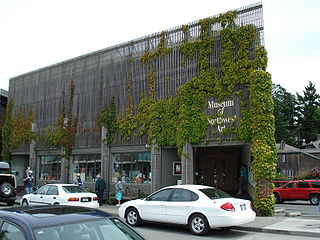
The Museum of Northwest Art is an art museum located in La Conner, Washington, and is focused on the Northwest School art movement, which had its peak in the mid-20th century. The Museum was founded by Art Hupy in 1981. It moved to its present building in 1995.
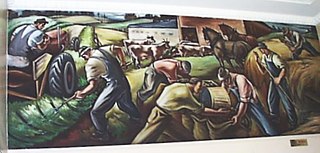
The Northwest School was an American art movement established in the Seattle area. It flourished in the 1930s–40s.

Morris Graves was an American painter. He was one of the earliest Modern artists from the Pacific Northwest to achieve national and international acclaim. His style, referred to by some reviewers as Mysticism, used the muted tones of the Northwest environment, Asian aesthetics and philosophy, and a personal iconography of birds, flowers, chalices, and other images to explore the nature of consciousness.

Guy Anderson was an American artist known primarily for his oil painting who lived most of his life in the Puget Sound region of the United States. His work is in the collections of numerous museums including the Seattle Art Museum, the Tacoma Art Museum, and the Metropolitan Museum of Art. He has been called "Perhaps the most powerful artist to emerge from the Northwest School".
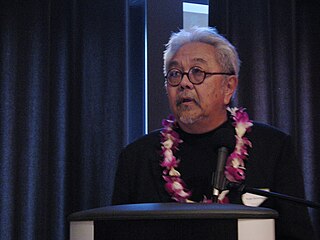
Roger Shimomura is an American artist and a retired professor at the University of Kansas, having taught there from 1969 to 2004. His art, showcased across the United States, Japan, Canada, Mexico, and Israel, often combines American popular culture, traditional Asian tropes, and stereotypical racial imagery to provoke thought and debate on issues of identity and social perception.
Art Hupy was an American freelance commercial photographer noted for his images of architecture and artists from the Northwest School. Hupy also founded the Museum of Northwest Art.

William Lee Cumming was a noted 20th-century American artist, often associated with the Northwest School. A controversial figure - he was a hardcore Stalinist for a long period, was married seven times, and was generally outspoken and opinionated - he eventually came to be respected as an important innovator and highly distinctive stylist in modern art, particularly in the Pacific Northwest.

Helmi Dagmar Juvonen was an American artist active in Seattle, Washington. Although she worked in a wide variety of media, she is best known for her prints, paintings, and drawings. She is associated with the artists of the Northwest School.
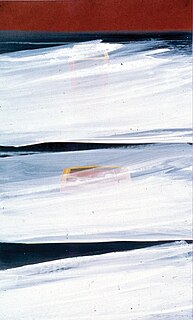
Ron Wigginton is an American artist and landscape architect. His paintings and sculptures are found in West Coast museums and many private collections. His landscapes are known for their narrative and aesthetic qualities, and his artwork typically involves and explores human perceptions of natural and built landscapes. Wigginton is considered to be one of the first Landscape Architects to approach the design of a landscape as a conceptual work of art, for which he has received international recognition through publication and awards.
Charles Stokes (1944–2008) was a painter and sculptor and a prominent member of the last generation of artists identified with the Northwest School. He was the first winner of the prestigious Betty Bowen Award in concert with the Seattle Art Museum in 1979. His works are held by Northwest museums and institutions, most prominently the Museum of Northwest Art in La Conner, Washington, and by numerous private collectors. Revered as an energetic, charismatic, original, and meticulous artist and teacher, he spent his final two decades in self-imposed isolation from the art world producing works seen only by intimates. Stokes was born in Tacoma, Washington. He lived and worked in the Northwest until the early 1990s, when he settled in Manhattan, New York City.
Charles Wing Krafft was an American painter and ceramicist whose later work incorporated traditional ceramic decorative styles to produce works commemorating modern disasters. In 1998, he was called "the dark angel of Seattle art" by the art critic of the Seattle Post-Intelligencer. In early 2013 it was revealed that he participated in white nationalist and Holocaust denial websites, which led to a re-evaluation of his artwork.
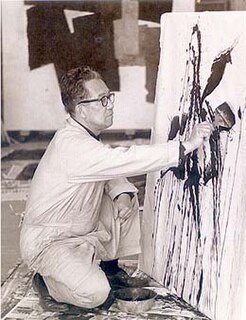
Paul Horiuchi was an American painter and collagist. He was born in Oishi, Japan, and studied art from an early age. After immigrating to the United States in his early teens, he spent many years as a railroad worker in the Western U.S. In 1946, he moved to Seattle, Washington, where he eventually switched his focus from painting to collage and came to be associated with the "Northwest School" of artists. In his mid-forties, he was finally able to devote himself to art full-time, his unusual collage style becoming very popular in the 1950s and 60s. He continued creating art at his studio in Seattle until succumbing to Alzheimer's-related health problems in 1999.
Tabaimo is a contemporary Japanese artist whose video installations have been exhibited around the world. She combines hand-drawn images and digital manipulation to create large scale animations which evoke traditional Japanese woodblock prints (ukiyo-e) while presenting a pointed, complex view of Japanese society.

Paul Havas was an American painter. Havas is known for his landscape paintings.

Richard Charles Gilkey was an American painter, often associated with the 'Northwest School' of artists. During his long career he became one of the most acclaimed painters in the Pacific Northwest, with an original and highly distinctive style. He was particularly well known for his landscapes depicting the Skagit Valley in western Washington.

William Ivey was an American abstract expressionist painter, sometimes associated with the Northwest School of artists. After stints in the US Army and studying art in California, he spent most of his career in Seattle, Washington. Seattle Times critic Deloris Tarzan Ament described him as "the Dean of Northwest Painters".

Fay Chong (1912–1973) was a Chinese-American artist and educator, well known for his printmaking and watercolor painting. He was also known for his activities as an arts organizer, arts educator and WPA-era artist. Chong was active in the Pacific Northwest.

Robert Bruce Inverarity was an American artist, art educator, museum director, author, and anthropologist. He was the Washington State Director of the Federal Arts Project from 1936 to 1939 and the Washington Arts Project from 1939 to 1941, working with many noted Pacific Northwest artists. Fascinated with the Indian tribes of the Northwest from early youth, he amassed a major collection of North Pacific Coast Native art and authored several works on the subject.
Barbara Straker James (1918-2007) was an American artist. She was the curator of the Museum of Northwest Art from 1991 to 2002.
















